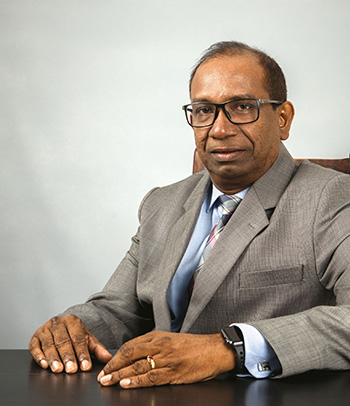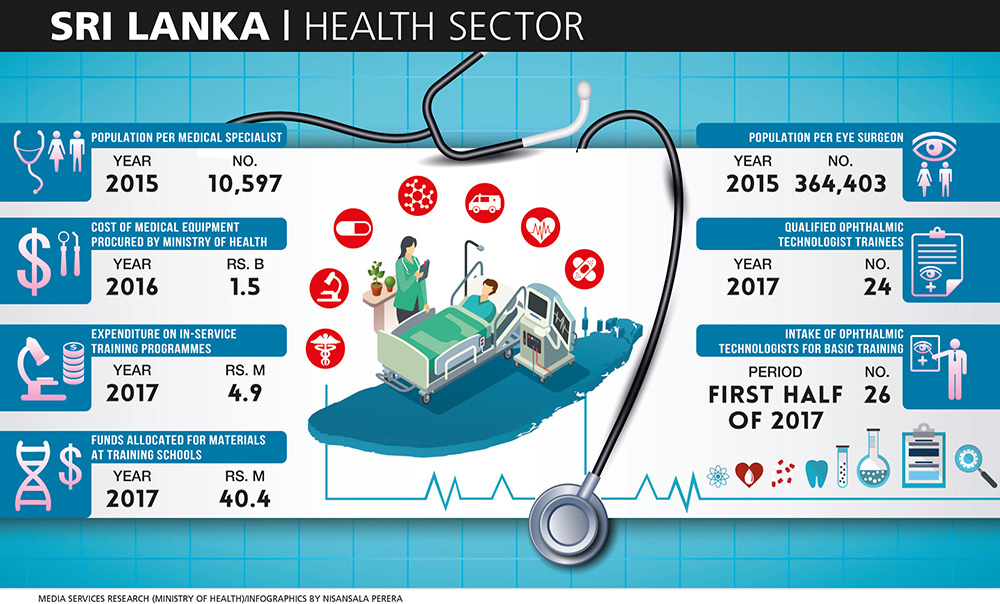EYE CARE SECTOR
VISUAL AID
THE BLIND NEED A VISION
Dasantha Fonseka sees an insightful way to aid the visually impaired
Compiled by Yamini Sequeira
Over 9.3 million Sri Lankans have some type of vision impairment and 8.2 million of them were over 40 years old in 2016. The most recent study reported a 1.5 percent prevalence of blindness. The prevalence of visual impairment is around 45 percent due to the ageing population with people over 40 deemed to need visual aid in one form or the other.
 Uncorrected refractive errors are the commonest cause of mild, moderate and even severe visual impairment.
Uncorrected refractive errors are the commonest cause of mild, moderate and even severe visual impairment.
The Chairman and Chief Executive Officer of Vision Care Optical Services Dasantha Fonseka, who has over 30 years’ experience in eye care, says: “It is said that eyes are the windows to the soul. Whether this is true or not, what we do know is that having perfectly healthy eyes – meaning excellent vision and clear eyes free of pain or other problems – is crucial to an individual’s health and wellbeing.”
“According to the WHO, Sri Lanka has significantly better primary eye care service coverage compared to its neighbours. However, optometry remains a sleeping giant due to the lack of statistical data and an inadequate information base for planning resource allocation,” he avers.
According to Fonseka, “the biggest challenge when it comes to eye health in Sri Lanka is the inequitable distribution of infrastructure and resources – including human resources and finance.”
He elaborates: “The majority of advanced eye care facilities are restricted to Colombo or its suburbs in both the state and private sectors. Inadequate statistics about eye health has resulted in blindness in the context of identifying requirements. Accessibility to reasonable health facilities should be available in remote areas as well.”
FUZZY STATISTICS The available statistics indicate the existence of around 105 ophthalmologists in Sri Lanka at present.

“Compared to developed countries, this number is low as the ratio is one ophthalmologist to 200,000 people. While the demand for ophthalmologists may be driven by the advanced ageing of our society, there’s also an expected increase in demand for eye care among younger patients in the future,” Fonseka cautions.
As with other paediatric services, the visual health of children is at a salutary level as there are adequate facilities and procedures to screen eye problems at an early stage, he notes. Newborns undergo a preliminary optical examination before being discharged from hospital and paediatric ophthalmology units too are well-established in children’s hospitals.
The good news is that the National Hospital of Sri Lanka and Teaching Hospital Kandy provide eyeglasses free of charge to needy people. What’s more, most leading opticians willingly provide free spectacles to schoolchildren and senior citizens upon confirmation of their lower economic status from the relevant Grama Niladhari or school principal.
Cataract surgery with intraocular lens (IOL) implantation is the most performed surgical procedure – and nearly 100 percent of the cataract surgery requirement in Sri Lanka is fulfilled.
“Due to the high quality of cataract surgery procedure available locally, there’s an encouraging trend of Sri Lankans residing abroad returning to have their own or their parents’ IOL implantations done in Sri Lanka. This is a positive in terms of medical tourism,” Fonseka affirms.
FASHION ACCESSORY There’s also a growing awareness of branded eyewear. Fonseka observes: “One in every eight people who purchases an optical frame looks for a branded option. Sri Lankans are aware of brands mainly due to social media, which is why they buy even fake Ray-Ban glasses or replicas – but wearing a pair of fake sunglasses is more dangerous than not wearing one!”
“People in Colombo and the suburbs are more brand conscious. Ownership of multiple brands or styles is an interesting trend among niche consumers. We expect the branded sunglasses market to be one of the fastest growing segments in the eyewear sector. The mushrooming of malls will definitely increase this number in the near future. Unfortunately, many fake products are smuggled into the country, which will have a huge negative impact on the branded market,” he laments.
Sharing tips for protecting one’s vision, Fonseka asserts that “it is very important to maintain a healthy weight for good vision. There are hundreds of things one can do to protect the eyes and wearing a pair of sunglasses or protective eye wear plays an important role. Sunglasses are considered a fashion accessory but their most important job is to protect the eyes from the sun’s UV rays.”
He sees great potential for expanding the eye care sector beyond Colombo and its suburbs. As Fonseka observes, “since Sri Lanka is very fortunate to possess skilled labour, there’s also the possibility of exporting value added optical products to neighbouring countries.”
SOCIETAL WELLBEING Fonseka opines that “although there are adequate facilities for education, rehabilitation programmes and assistance for self-employment, I doubt whether Sri Lanka has a proper socialisation programme for the visually impaired.”
He explains that a “lack of employment opportunities, access to public places and facilities, and technical resources designed for the visually handicapped are some of the well-known practical issues they face.”
“It is a national requirement to create an environment that caters to all kinds of people. As an eye-opener, I would ask how many lifts you have seen in Sri Lanka with buttons that have numbers in braille?” he enquires.
Although braille is widely used among those who are visually handicapped from birth, Fonseka notes that some people experience optical impairment at a later age and are thus reluctant to learn braille. Therefore, the quality of life of the visually handicapped and partially sighted depends on the type and duration of impairment, as well as their participation in rehabilitation programmes.
Says Fonseka: “In Sri Lanka, the private sector plays a critical role in fulfilling the eye care needs of the country without placing the burden completely on the state. As an entrepreneur however, I have experienced more criticism than appreciation in this process perhaps due to the wrong perceptions of some government officials and competitive groups.”
The retail environment in the opticians’ market remains highly competitive, and expansion and consolidation remain key features. Fonseka concludes that even though the market is expected to remain highly competitive over the next few years, the potential to grow the eye care sector is huge.
The interviewee is the Chairman and Chief Executive Officer of Vision Care Optical Services





